Agriculture and Green Economy for Environmental Kuznets Curve Adoption in Developing Countries: Insights from Rwanda
Abstract
:1. Introduction
- -
- Identify whether developing countries with green economy policies like Rwanda could adopt the EKC, mostly adopted by advanced counties. Through the relationship classification between CO2-GDPc and CO2-AGRc. As either relative decoupling, absolute decoupling, relative coupling, absolute coupling, or no relationship.
- -
- Explore the GDPc and AGRc impact on CO2 emissions;
- -
- Precise the causality directions through short-run and long-run stability;
- -
- Classify the existing weaknesses, opportunities, and improvement strategies.
2. Material and Methods
2.1. Theoretical Approach
2.1.1. Green Growth Grants to Agriculture and Economy
2.1.2. Agricultural Grants to Economy and Environment
2.1.3. Status of Green and No Green Growth Sectors in Rwanda
2.2. Description of Variables
2.3. Model Specification
2.3.1. Tests for the EKC or GBMLQ Inverted U-Shape Hypothesis
2.3.2. ARDL Method for Cointegration
2.3.3. Model Estimation
2.3.4. Causality
2.4. Model Diagnostics
3. Data Analysis and Discussion
3.1. Data Analysis
3.1.1. Summary Statistics
3.1.2. Lag Selection
3.1.3. Cointegration Test
3.1.4. Relevant Equation for the Model
3.1.5. Residual Diagnostics
3.1.6. Stability Diagnostic
3.1.7. Causality
3.2. Discussion
4. Conclusions and Policy Implication
Author Contributions
Funding
Conflicts of Interest
References
- Falcone, P.M.; González García, S.; Imbert, E.; Lijó, L.; Moreira, M.T.; Tani, A.; Tartiu, V.E.; Morone, P. Transitioning towards the bio-economy: Assessing the social dimension through a stakeholder lens. Corp. Soc. Responsib. Environ. Manag. 2019, 26, 1135–1153. [Google Scholar] [CrossRef] [Green Version]
- Sarkar, S.F.; Poon, J.S.; Lepage, E.; Bilecki, L.; Girard, B. Enabling a sustainable and prosperous future through science and innovation in the bioeconomy at Agriculture and Agri-Food Canada. N. Biotechnol. 2018, 40, 70–75. [Google Scholar] [CrossRef] [PubMed]
- Balogh, J.M.; Jámbor, A. Determinants of CO2 emission: A global evidence. Int. J. Energy Econ. Policy 2017, 7, 217–226. [Google Scholar]
- Gessesse, A.T.; He, G. Analysis of carbon dioxide emissions, energy consumption, and economic growth in China. Agric. Econ. 2020, 2020, 183–192. [Google Scholar] [CrossRef]
- Timilsina, G.R. Will global convergence of per-capita emissions lead the way to meeting the UNFCCC goal? Carbon Manag. 2016, 7, 125–136. [Google Scholar] [CrossRef] [Green Version]
- Government of Rwanda Law N° 16/2006 of 03/04/2006 Determining the Organization, Functioning and Responsibilities of Rwanda Environment Management Authority. Available online: https://primature.gov.rw (accessed on 30 June 2020).
- Republic of Rwanda Five Years Strategic Plan for the Environment and Natural Resources Sector (2009–2013). Available online: https://www.rema.gov.rw/rema_doc/Planing_Dpt/Five%20years%20Strategic%20plan%20for%20the%20Environment%20and%20Natural%20Resources%20Sector%20(2009%20-%202013).pdf (accessed on 12 May 2020).
- Republic of Rwanda Review of Environment and Natural Resources Sector Policies. Available online: http://www.gicumbi.gov.rw/fileadmin/templates/document/ENR_Policy_Review_1_.pdf (accessed on 8 July 2020).
- Maniriho, A.; Bizoza, A. Financial Benefit-Cost Analysis of Agricultural Production in Musanze District, Rwanda. Acad. Arena 2013, 3, 92–99. [Google Scholar]
- Republic of Rwanda Rwandan Gross Gomestic Product Fiscal Year 2018_19. Available online: https://www.statistics.gov.rw/statistical-publications/subject/gross-domestic-product-%28gdp%29 (accessed on 2 April 2020).
- Republic of Rwanda Annual Report 2009/2010. Available online: https://www.minagri.gov.rw/publications/reports (accessed on 2 August 2020).
- Niyigaba, J.; Peng, D. Analysis and Forecasting the Agriculture Production Sector in Rwanda. Int. J. Econ. Financ. 2020, 12, 91. [Google Scholar] [CrossRef]
- UNEP. Green Economy. Available online: https://www.unenvironment.org/regions/asia-and-pacific/regional-initiatives/supporting-resource-efficiency/green-economy (accessed on 30 July 2020).
- Bagstad, K.J.; Ingram, J.C.; Lange, G.; Masozera, M.; Ancona, Z.H.; Bana, M.; Kagabo, D.; Musana, B.; Nabahungu, N.L.; Rukundo, E.; et al. Towards ecosystem accounts for Rwanda: Tracking 25 years of change in flows and potential supply of ecosystem services. People Nat. 2020, 2, 163–188. [Google Scholar] [CrossRef]
- Nishimwe, G.; Rugema, D.M.; Uwera, C.; Graveland, C.; Stage, J.; Munyawera, S.; Ngabirame, G. Natural capital accounting for land in Rwanda. Sustainability 2020, 12, 70. [Google Scholar] [CrossRef]
- Republic of Rwanda Updated Nationally Determined. Available online: https://www.environment.gov.rw (accessed on 3 November 2020).
- Green Fund of Rwanda Investing in a Green and Climate Resilient Rwanda. Available online: http://www.fonerwa.org/publications (accessed on 3 November 2020).
- Weatherspoon, D.D.; Miller, S.; Ngabitsinze, J.C.; Weatherspoon, L.J.; Oehmke, J.F. Stunting, food security, markets and food policy in Rwanda. BMC Public Health 2019, 19, 1–13. [Google Scholar] [CrossRef] [Green Version]
- Marcello, P.; Tani, A.; Elena, V.; Imbriani, C.; Sapienza, U.; Elena, V.R. Towards a sustainable forest-based bioeconomy in Italy: Findings from a SWOT analysis. For. Policy Econ. 2020, 110, 101–110. [Google Scholar] [CrossRef]
- Esteban, E.; Garrido, P.; Sanz-hern, A. Transition to a bioeconomy: Perspectives from social sciences. J. Clean. Prod. 2019, 224, 107–119. [Google Scholar] [CrossRef] [Green Version]
- Food and Agriculture Organization (FAO). Greening the Ecomomy with Agriculture. Available online: http://www.fao.org/3/a-ar585e.pdf (accessed on 3 September 2020).
- Eniko Artim, E.B. Investing in the Environment as a Way to Stimulate Economic Growth and Employment. Available online: https://ec.europa.eu/environment/archives/integration/pdf/LisbonReport.pdf (accessed on 12 March 2020).
- Stockholm Environment Institute. Economics of Climate Change in Rwanda. Available online: https://www.rema.gov.rw/fileadmin/templates/Documents/rema_doc/CCdepart/EconomicsofCCinRwanda.pdf (accessed on 11 February 2020).
- REMA. State of Environment and Outlook Report. Available online: https://www.rema.gov.rw/fileadmin/templates/Documents/rema_doc/SoE/RwandaSOE2017.pdf (accessed on 2 August 2020).
- Howmuch Visualizing the Importance of Agriculture in the World’s Economy. Available online: https://howmuch.net/articles/role-agriculture-around-the-world (accessed on 15 March 2020).
- IPCC. Agriculture, Forestry and Other Land Use (AFOLU). In Climate Change 2014 Mitigation of Climate Change; Cambridge University Press: Cambridge, UK, 2015; pp. 811–922. [Google Scholar] [CrossRef] [Green Version]
- Wang, J.J.; Hu, C.X.; Bai, J.; Gong, C.M. Carbon sequestration of mature black locust standson the loess plateau, China. Plant Soil Environ. 2015, 61, 116–121. [Google Scholar] [CrossRef] [Green Version]
- FAO. Forests and Agriculture: Land-Use Challenges and Opportunities; Food and Agriculture Organization of the United Nations: Rome, Italy, 2016; Volume 45, pp. 1545–2050. ISBN 1543-5938. [Google Scholar]
- Acaravci, A.; Ozturk, I. On the relationship between energy consumption, CO2 emissions and economic growth in Europe. Energy 2010, 35, 5412–5420. [Google Scholar] [CrossRef]
- Menyah, K.; Wolde-Rufael, Y. Energy consumption, pollutant emissions and economic growth in South Africa. Energy Econ. 2010, 32, 1374–1382. [Google Scholar] [CrossRef]
- Pao, H.T.; Fu, H.C.; Tseng, C.L. Forecasting of CO2 emissions, energy consumption and economic growth in China using an improved grey model. Energy 2012, 40, 400–409. [Google Scholar] [CrossRef]
- Bădîrcea, R.M.; Florea, N.M.; Manta, A.G.; Puiu, S.; Doran, M.D. Comparison between Romania and Sweden Based on Three Dimensions: Environmental Performance, Green Taxation and Economic Growth. Sustainability 2020, 12, 3817. [Google Scholar] [CrossRef]
- Niyigaba, J.; Peng, D. Developing countries economic growth, causality and convergence: Rwanda and peru. Russ. J. Agric. Socio-Econ. Sci. 2020, 103, 92–102. [Google Scholar] [CrossRef]
- Mikayilov, J.I.; Hasanov, F.J.; Galeotti, M. Decoupling of CO2 emissions and GDP: A time-varying cointegration approach. Ecol. Indic. 2019, 95, 615–628. [Google Scholar] [CrossRef]
- Bony, J.M. Solutions globales bornées pour les modèles discrets de l’équationde Boltzmann en dimension 1 d’espace. Journées Équations aux dérivées partielles 2018, 16, 1–10. [Google Scholar]
- Peter, P. Testing for a unit root in time series regression. Biometrika 1988, 75, 335–346. [Google Scholar]
- Dickey, F. Likelihood Ratio Statistics for Autoregressive Time Series with a Unit Root. Econometrica 1981, 49, 1057–1072. [Google Scholar] [CrossRef]
- Martínez-Zarzoso, I.; Bengochea-Morancho, A. Pooled mean group estimation of an environmental Kuznets curve for CO2. Econ. Lett. 2004, 82, 121–126. [Google Scholar] [CrossRef]
- Rahman, M.M. Environmental degradation: The role of electricity consumption, economic growth and globalisation. J. Environ. Manag. 2020, 253, 109742. [Google Scholar] [CrossRef] [PubMed]
- Wang, Q.; Xiao, K.; Lu, Z. Does Economic Policy Uncertainty Affect CO2 Emissions? Empirical Evidence from the United States. Sustainability 2020, 12, 9108. [Google Scholar] [CrossRef]
- Pesaran, M.H.; Shin, Y.; Smith, R.J. Bounds testing approaches to the analysis of level relationships. J. Appl. Econom. 2001, 16, 289–326. [Google Scholar] [CrossRef]
- Widodo, A.; Budi, I.; Widjaja, B. Automatic lag selection in time series forecasting using multiple kernel learning. Int. J. Mach. Learn. Cybern. 2016, 7, 95–110. [Google Scholar] [CrossRef]
- Kuznets, S. Economic Growth and Income Inequality. Am. Econ. Rev. 1955, 45, 1–28. [Google Scholar]
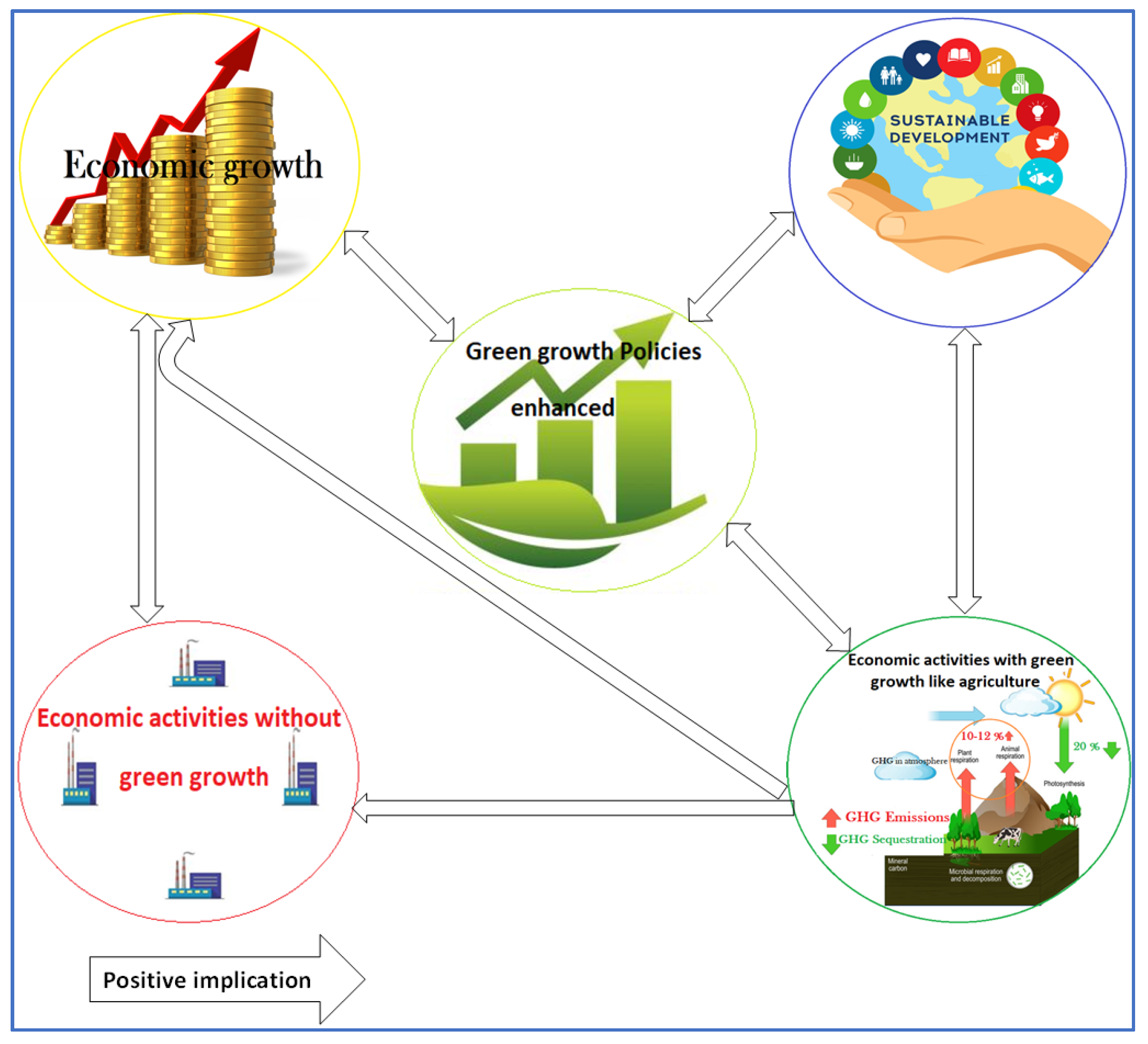

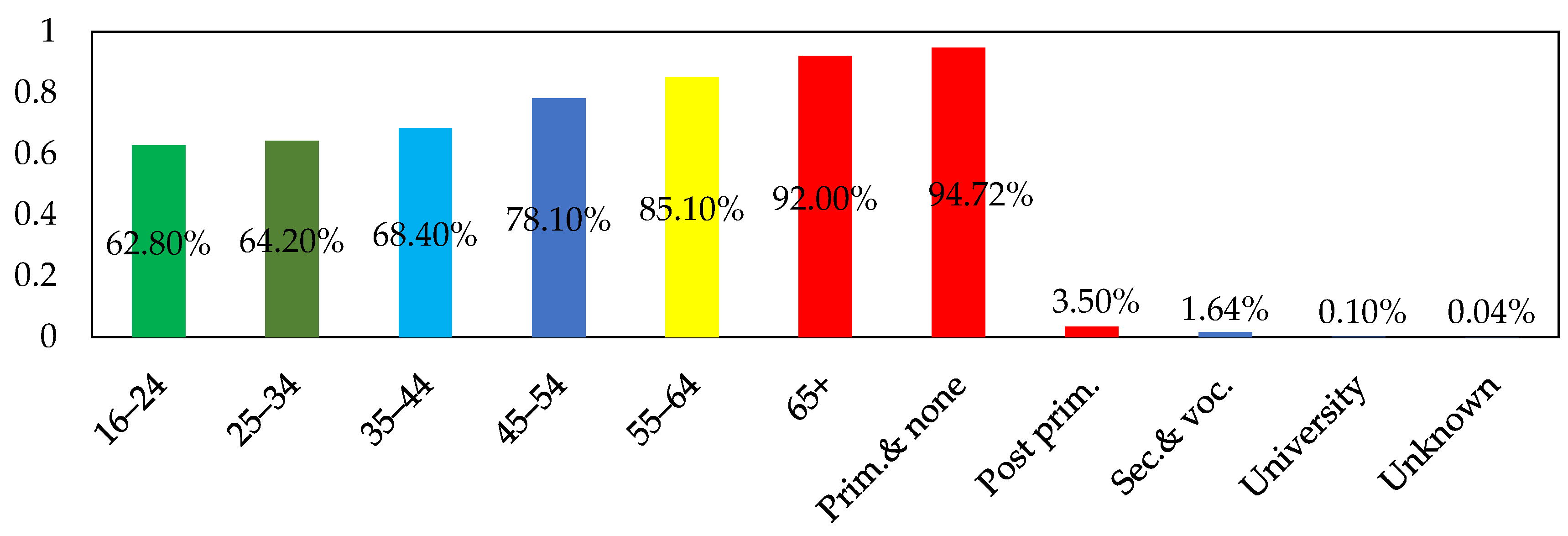

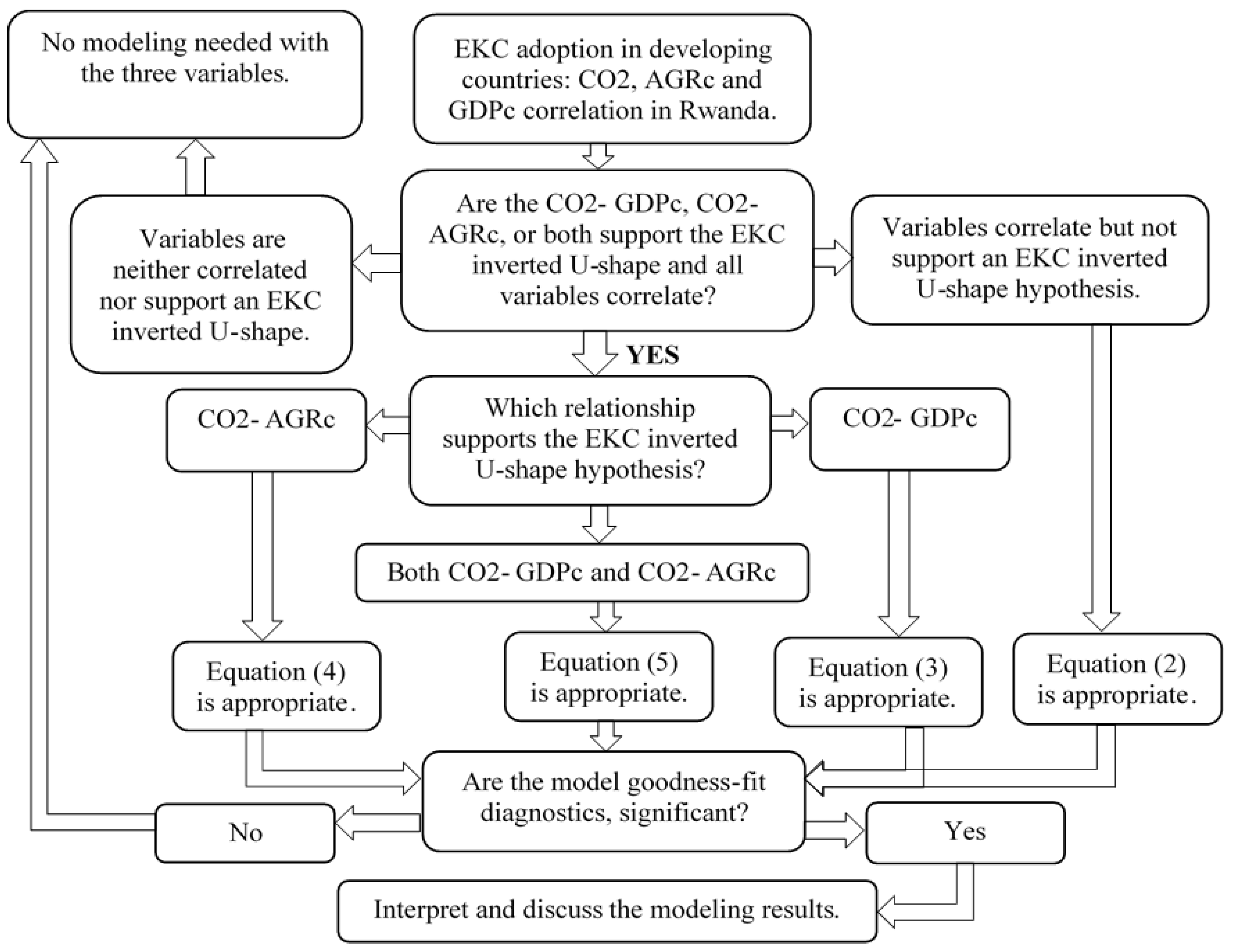

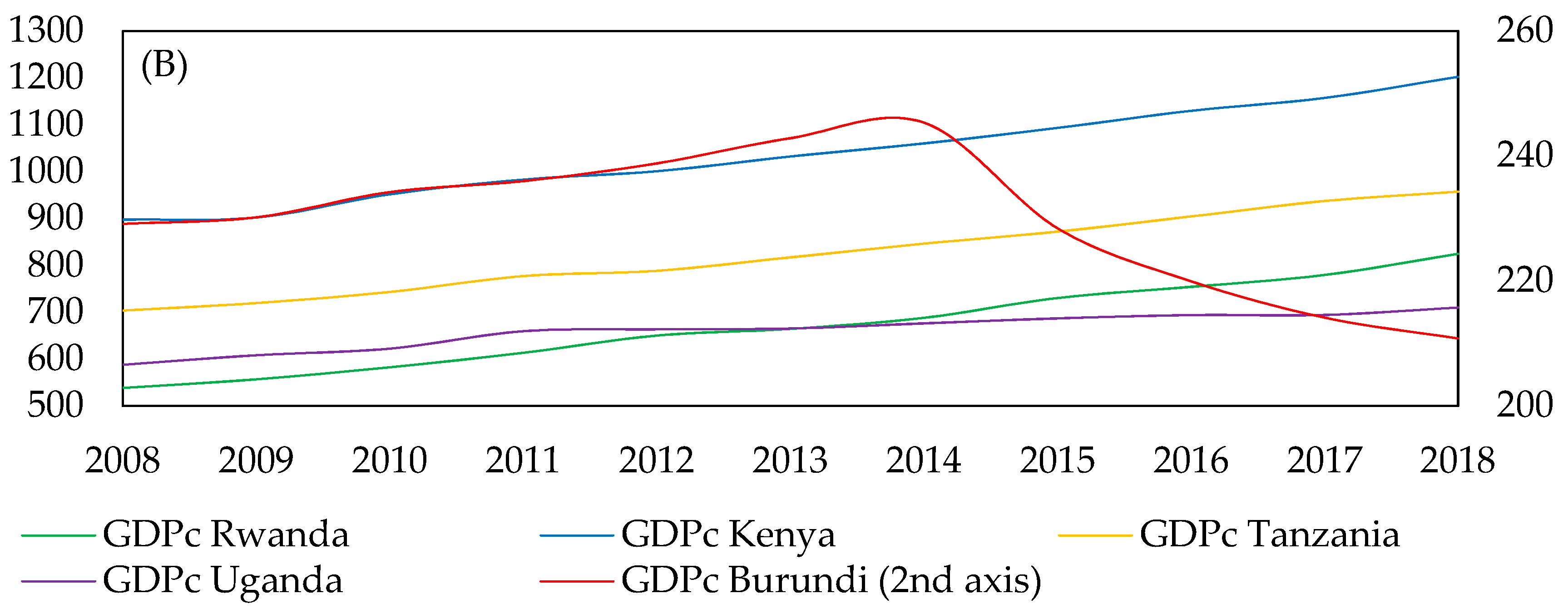

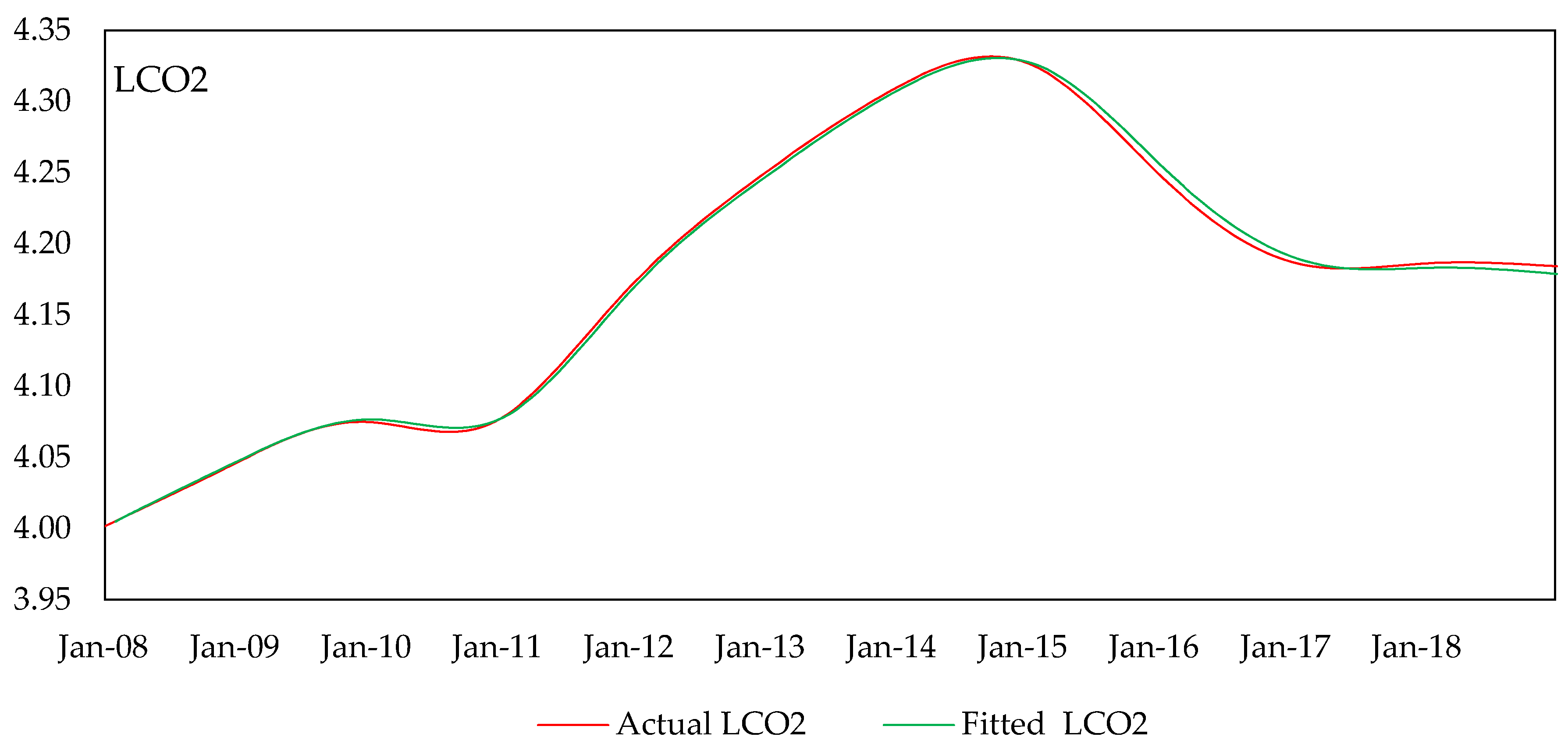

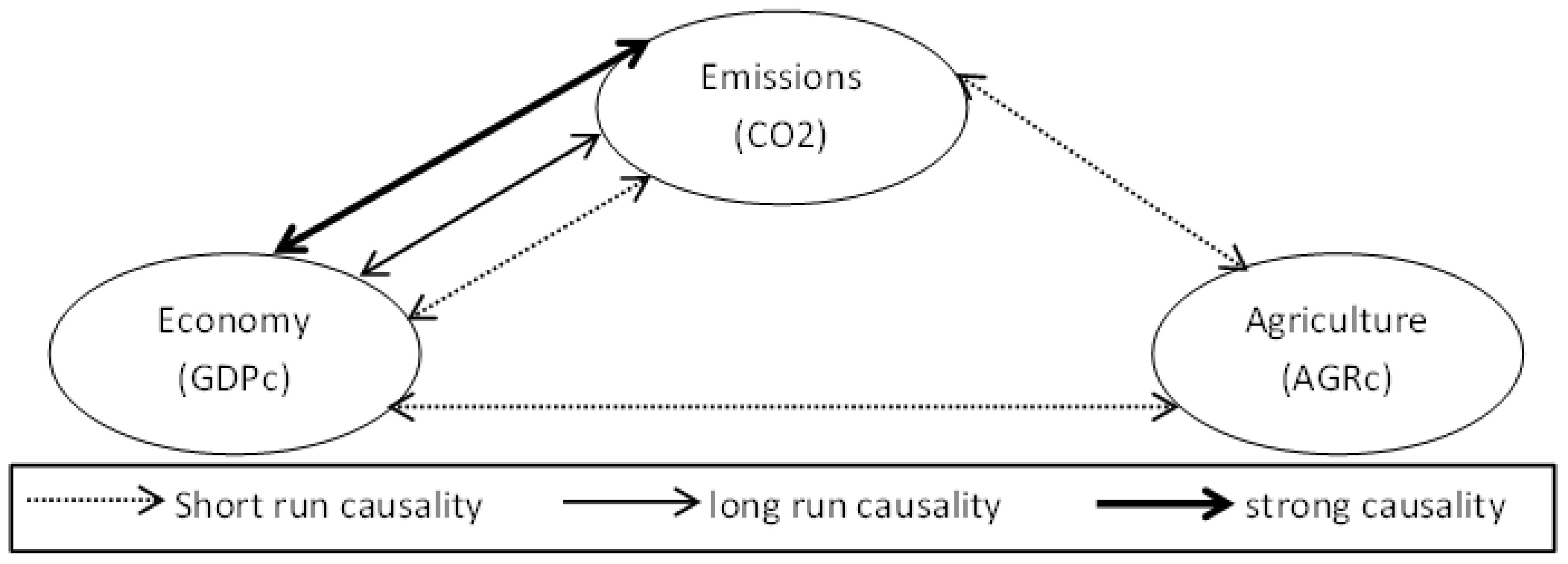
| Sector’s Shares (%) | 2006 | 2008 | 2010 | 2012 | 2014 | 2016 | 2018 | Average |
|---|---|---|---|---|---|---|---|---|
| Agriculture | 33 | 29 | 28 | 29 | 28 | 30 | 28 | 29 |
| Green growth services | 44 | 48 | 47 | 47 | 48 | 47 | 48 | 47.4 |
| No green growth industry | 16 | 15 | 17 | 18 | 17 | 16 | 17 | 16.5 |
| Taxes | 7 | 8 | 8 | 6 | 7 | 7 | 7 | 7.1 |
| Years | 2002 | 2006 | 2010 | 2014 | 2018 | Average | |
|---|---|---|---|---|---|---|---|
| Employment Proportion % | 86.6 | 79 | 72.5 | 67.6 | 69.8 | 75.1 | |
| Highest level of education | |||||||
| Education levels % | 2002 | 2006 | 2010 | 2014 | 2018 | Average | |
| Primary, unknown & none | 96.1 | 96.6 | 96.6 | 90.1 | 94.4 | 94.76 | |
| Post primary | 2.3 | 1.8 | 1.1 | 7 | 5.3 | 3.50 | |
| Secondary & vocational | 1.6 | 1.5 | 2.1 | 2.7 | 0.3 | 1.64 | |
| University | 0 | 0.1 | 0.2 | 0.2 | 0.0 | 0.10 | |
| Age group | |||||||
| Age group | 16–24 | 25–34 | 35–44 | 45–54 | 55–64 | 65+ | Average |
| percentages | 62.8 | 64.2 | 68.4 | 78.1 | 85.1 | 92.0 | 75.1 |
| Variables Statistics | GDPc | AGRc | CO2 (000) |
|---|---|---|---|
| Mean | 671.2521 | 175.2087 | 66.0352 |
| Standard deviation | 93.9015 | 15.3508 | 6.1827 |
| Coefficient of variation CV (%) | 13.9890 | 8.7614 | 9.3627 |
| Country | Years | Variables | Average Annual Growth Rates (AAGR in %) | Compound Annual Growth Rates (CAGR %) |
|---|---|---|---|---|
| Rwanda | (2008–2013) | GDPc | 4.30 | 4.29 |
| AGRc | 2.79 | 2.78 | ||
| CO2 (000) | 5.50 | 5.45 | ||
| (2013–2018) | GDPc | 4.42 | 4.41 | |
| AGRc | 2.90 | 2.89 | ||
| CO2 (000) | −2.31 | −2.38 | ||
| Burundi | (2008–2013) | GDPc | 1.17 | 1.17 |
| AGRc | −1.29 | −1.35 | ||
| CO2 (000) | 5.48 | 5.29 | ||
| (2013–2018) | GDPc | −2.76 | −2.79 | |
| AGRc | −4.18 | −4.20 | ||
| CO2 (000) | 18.80 | 17.59 | ||
| Kenya | (2008–2013) | GDPc | 2.85 | 2.84 |
| AGRc | 0.97 | 0.90 | ||
| CO2 (000) | 3.04 | 2.62 | ||
| (2013–2018) | GDPc | 3.09 | 3.09 | |
| AGRc | 2.02 | 2.01 | ||
| CO2 (000) | 2.09 | 1.92 | ||
| Tanzania | (2008–2013) | GDPc | 3.04 | 3.04 |
| AGRc | 0.21 | 0.21 | ||
| CO2 (000) | 9.79 | 9.45 | ||
| (2013–2018) | GDPc | 3.22 | 3.21 | |
| AGRc | 2.64 | 2.64 | ||
| CO2 (000) | 5.69 | 5.59 | ||
| Uganda | (2008–2013) | GDPc | 2.53 | 2.51 |
| AGRc | −0.86 | −0.87 | ||
| CO2 (000) | 5.73 | 5.41 | ||
| (2013–2018) | GDPc | 1.31 | 1.31 | |
| AGRc | −0.97 | −0.97 | ||
| CO2 (000) | 1.68 | 1.60 |
| Lag | LogL | LR | FPE | AIC | SC | HQ |
|---|---|---|---|---|---|---|
| 0 | 232.1130 | NA | 0.001799 | −3.482642 | −3.394849 | −3.446968 |
| 1 | 554.3840 | 619.9412 * | 1.33 × 10−5 * | −8.387543 * | −8.277802 * | −8.342950 * |
| 2 | 156.0872 | 65.3826 | 2.64 × 10−17 | −27.2174 | −26.6123 | −27.8813 |
| Tests | ADF | PP | ||
|---|---|---|---|---|
| Level | 1st Diff. | Level | 1st Diff. | |
| LCO2 (000) | −2.19 | −1.54 * | 0.61 | −1.62 * |
| LGDPc | −0.0026 | −4.51 ** | 0.40 | −4.77 *** |
| LGDPc2 | 0.18 | −4.87 *** | 0.91 | −5.05 *** |
| LAGRc | 0.06 | −6.48 *** | −1.24 | −14.13 *** |
| LAGRc2 | 0.21 | −6.51 *** | −0.93 | −13.00 *** |
| Equation | Independent Variables | Intercept | Test Statistic | ||||
|---|---|---|---|---|---|---|---|
| LGDPc (−1) | LGDPc2 (−1) | LAGRc (−1) | LAGRc2 (−1) | R2-Adjusted | R2-Adjusted Comparison | ||
| Equation (2) | 0.145659 | 0.516941 | 0.575084 | 0.425584 | |||
| Equation (3) | 50.65348 | −3.842931 | −0.667313 | −159.1832 | 0.885569 | (3)-(2) = 39% | |
| Equation (4) | 1.131848 | 79.42100 | −7.821303 | −204.6764 | 0.737725 | (4)-(2) = 31.21% | |
| Equation (5) | 149.9745 | −11.57183 | −183.8918 | 17.92589 | −10.06670 | 0.882306 | (5)-(3) = 6.67% |
| Function | F-Statistic Value | Lags | Significance Levels | Cointegrated | ||
|---|---|---|---|---|---|---|
| Levels | Lower Bound I (0) | Upper Bound I (1) | ||||
| LCO2(000) = F (LGDPc, LGDPc2, LAGRc) | 11.3278 | 1, 1, 1, 1 | 10% | 2.72 | 3.77 | Yes |
| 5% | 3.23 | 4.35 | ||||
| 1% | 4.29 | 5.61 | ||||
| LGDPc = F(LCO2(000), LGDPc2, LAGRc) | 916.1651 | 1, 1, 1, 1 | 10% | 2.72 | 3.77 | Yes |
| 5% | 3.23 | 4.35 | ||||
| 1% | 4.29 | 5.61 | ||||
| LGDPc2 = F(LCO2(000), LGDPc, LAGRc) | 921.6545 | 1, 1, 1, 1 | 10% | 2.72 | 3.77 | Yes |
| 5% | 3.23 | 4.35 | ||||
| 1% | 4.29 | 5.61 | ||||
| LAGRc = F(LCO2(000), LGDPc, LGDPc2) | 6.0842 | 1, 1, 1, 1 | 10% | 2.72 | 3.77 | Yes |
| 5% | 3.23 | 4.35 | ||||
| 1% | 4.29 | 5.61 | ||||
| Long-Run Model Diagnostic Tests | Short-Run Model Diagnostic Tests | |||||||
|---|---|---|---|---|---|---|---|---|
| Residual diagnostics | Serial Correlation | Breusch-Godfrey LM test | R2 observed | 3.0980 ** (0.0784) | Serial Correlation | Breusch-Godfrey LM test | R2 observed | 7.0933 (0.0077) |
| Q-statistic probability | Q-stat. | 0.3570 ** (0.5500) | Q-statistic probability | Q-stat. | 4.7167 * (0.0300) | |||
| Heteroskedasticity | Breusch-Pagan test | R2 observed | 5.2116 ** (0.3654) | Heteroskedasticity | Breusch-Pagan test | R2 observed | 6.0445 *** (0.3018) | |
| Stability diagnostics | Miss specification test | Ramsey’s test | t-statistic | 1.9555 *** (0.1222) | Miss specification test | Ramsey’s test | t-statistic | 0.5397 *** (0.6435) |
| F-statistic | 3.8243 *** (0.1222) | F-statistic | 0.2912 *** (0.6435) | |||||
| Recursive estimation | CUSUM | 5% level | Results within 5% level | Recursive estimation | CUSUM | 5% level | Results within 5% level | |
| Variables | Coefficients | Std. Error | t-Statistic | p | R-Squared |
| Long-run estimates | |||||
| LCO2(000) (−1) | 0.977798 | 0.007480 | 130.7264 *** | 0.0000 | 0.9987 |
| LGDPc (−1) | 2.007458 | 0.456357 | 4.398879 *** | 0.0000 | |
| LGDPc2 (−1) | −0.148602 | 0.034636 | −4.290376 *** | 0.0000 | |
| LAGRc (−1) | −0.141488 | 0.036465 | −3.880119 *** | 0.0002 | |
| Intercept | −5.943106 | 1.438350 | −4.131891 *** | 0.0001 | |
| Short-run estimates | |||||
| ∆LCO2(000) (−1) | 0.997164 | 0.008312 | 119.9664 *** | 0.0000 | 0.9939 |
| ∆LGDPc (−1) | 0.867327 | 0.480245 | 1.806010 * | 0.0733 | |
| ∆LGDPc2 (−1) | −0.067058 | 0.036874 | −1.818578 * | 0.0714 | |
| ∆LAGRc (−1) | −0.217765 | 0.028477 | −7.647130 *** | 0.0000 | |
| Intercept | 0.000491 | 0.000114 | 4.294216 *** | 0.0000 | |
| VECM estimates | |||||
| ∆LCO2(000) (−1) | 0.983190 | 0.027120 | 36.25342 *** | 0.0000 | 0.9939 |
| ∆LGDPc (−1) | 1.319094 | 0.963334 | 1.369301 ** | 0.0334 | |
| ∆LGDPc2 (−1) | −0.101936 | 0.074272 | −1.372482 ** | 0.0324 | |
| ∆LAGRc (−1) | −0.223091 | 0.030204 | −7.386247 *** | 0.0000 | |
| ECTt−1 | −0.016356 | 0.030205 | 0.541490 ** | 0.0291 | |
| Intercept | 0.000523 | 0.000129 | 4.041930 *** | 0.0001 | |
| Causal Source (Indep. var.) | Dep. Variables | ||||||||
|---|---|---|---|---|---|---|---|---|---|
| Short-Run Causal | Long Run Causal | Joint (Short & Long Run) | |||||||
| LCO2 | LGDPc LGDPc2 | LAGRc | LCO2 ECT | LGDPc ECT | LAGRc ECT | LCO2, ECT | LGDPc, ECT | LAGRc, ECT | |
| χ2-Statistic | t-Statistic | t-Statistic | t-Statistic | F-Statistic | |||||
| LCO2 | 52.14 *** | 11.98 ** | 22.40 *** | 1.62 | 26.07 ** | 5.99 | |||
| LGDPc | 74.29 *** | 13.5 *** | 22.52 *** | −1.63 | 37.2 ** | 6.73 | |||
| LAGRc | 17.92 ** | 13.06 ** | 1.26 | −1.28 | 8.96 | 6.53 | |||
Publisher’s Note: MDPI stays neutral with regard to jurisdictional claims in published maps and institutional affiliations. |
© 2020 by the authors. Licensee MDPI, Basel, Switzerland. This article is an open access article distributed under the terms and conditions of the Creative Commons Attribution (CC BY) license (http://creativecommons.org/licenses/by/4.0/).
Share and Cite
Niyigaba, J.; Ya Sun, J.; Peng, D.; Uwimbabazi, C. Agriculture and Green Economy for Environmental Kuznets Curve Adoption in Developing Countries: Insights from Rwanda. Sustainability 2020, 12, 10381. https://doi.org/10.3390/su122410381
Niyigaba J, Ya Sun J, Peng D, Uwimbabazi C. Agriculture and Green Economy for Environmental Kuznets Curve Adoption in Developing Countries: Insights from Rwanda. Sustainability. 2020; 12(24):10381. https://doi.org/10.3390/su122410381
Chicago/Turabian StyleNiyigaba, Jean, Jessica Ya Sun, Daiyan Peng, and Clemence Uwimbabazi. 2020. "Agriculture and Green Economy for Environmental Kuznets Curve Adoption in Developing Countries: Insights from Rwanda" Sustainability 12, no. 24: 10381. https://doi.org/10.3390/su122410381






